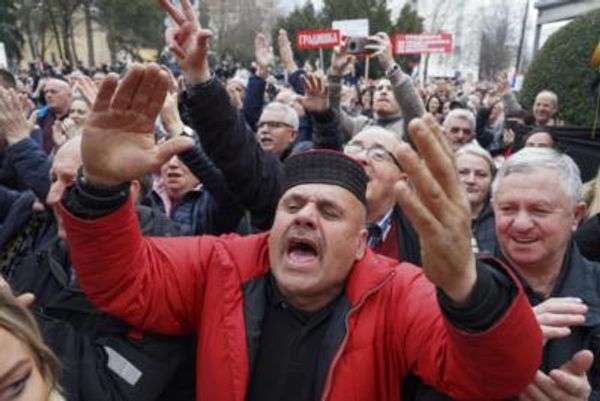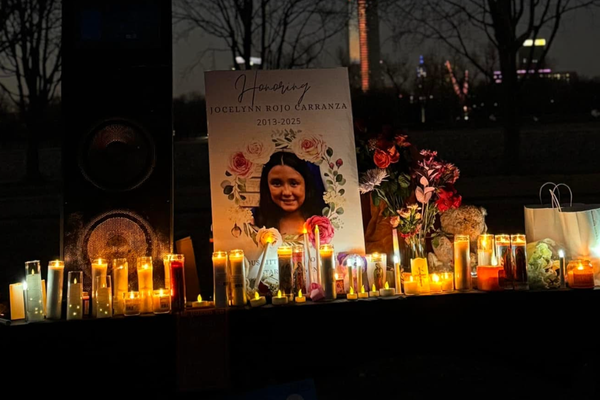THESE past few days, I’ve had the sharpest of reminders that the war is everywhere in Ukraine.
Last week, I was hundreds of miles to the east in the Donbas working in an area deemed one of the many “real” frontlines in this war.
Returning to the capital Kyiv with its bustling streets and cafe goers enjoying the first of the summer sun it’s easy to become complacent. The sharp end of the war fades quickly – or so it might seem.
That sense of comparative relaxation was especially pronounced last Sunday during what’s known as Kyiv Day, effectively the city’s birthday, having been founded more than 1500 years ago.
As part of those celebrations, Kyivans in their thousands had gone outdoors, many of them visiting what’s known as the Klitschko Glass Bridge, a pedestrian and cycle walkway that connects two parks in Kyiv, the Saint Volodymyr Hill and Khreshchatyi Park.
The atmosphere was terrific, a sense of escape and welcome indulgence in the need to forget the horrors of the war.
For hours, I mingled with Kyiv’s citizens and buskers on the walkway and watched as toddlers were given pony rides and the chance to drive miniature toy cars as their parents snapped pictures on their mobile phones for their family photo albums.
For most of the day, the war did not intrude, at least not openly. Only on leaving the park and walking along the city’s Triokhsviatytelska Street outside Mykhailivsky Golden-Domed Monastery, did the war once again begin to make its presence felt.
The woman who stopped me alongside the Wall of Remembrance of the Fallen for Ukraine spoke initially to me in Ukrainian, but on realising I was foreign, then spoke in English.
“I need your help,” she told me. From her bag, she took out two photographs and explained that she wanted to place them on the wall alongside the countless other images of mainly young men and women whose portraits on the wall are poignant reminders of the human toll this conflict has taken these past 15 months or so.
“Can you film this on my phone as I put the photographs up?” The woman, who was probably in her forties, asked, handing me her mobile.
“Could you make two separate films as I put each photograph up?”
Having agreed, I watched as she peeled the sticky backing from the photographs and stretched to place them on the top row. On each image, the faces of two young men in battle fatigues on a frontline somewhere, stared back at us smiling.
On one of the photographs alongside a small emblematic Ukrainian flag, there was also the flag of Georgia, a country that in the past, like Ukraine, has been on the receiving end of Russian invasion and aggression. I noticed also that the date of the young men’s deaths had been very recent.
I mentioned the Georgian flag to the woman and she explained that the young man had been a volunteer with one of the international brigades that fight alongside the Ukrainian forces here.
“They were both my friends,” she said simply by way of explanation, as I left her to be alone for a few minutes before the mementos of her fallen friends and wipe away the tears.
Already, the war was again beginning to intrude on what up until then had been a peaceful Sunday and moment of escape.
Then, overnight, a huge wave of Russian drones bore down on Kyiv, bringing back its ugly reality with a vengeance.
By Monday morning, the relaxed innocence of the toddlers I’d seen the day before smiling and playing in the park was replaced with images of terrified, screaming schoolchildren, racing for bomb shelters as Russian missiles rained down in the first daytime raid on Kyiv since December last year – days before my last visit.
Make no mistake about it – these missiles were targeting the heart of the city. A daytime city when people are out and about and at work. Russia might say it only strikes at military targets – but this is patently untrue.
Here in Kyiv and in other towns and cities across Ukraine where people have adapted the routines of ordinary life to wartime, Monday’s barrage of missiles followed by more mass drone attacks on Tuesday night, was yet another reminder that the civilian population are deemed “fair” and “legitimate” targets as far as the Kremlin is concerned.
Early Tuesday morning, of course, some people in Moscow woke up to the sound of explosions in their own city for the first time. While Ukraine denies launching drone attacks on the Russian capital, whoever is responsible is forcing Russians to talk about the war and help end the prevailing complacency in which Russians accept the conflict as something that does not threaten their own lives.
No sane or sensible person welcomes a tit-for-tat escalation, but Russia cannot be allowed to continue airbrushing the reality of the war from its own citizens. Only with the realisation of what Ukrainians are undergoing as a result of Russian president Vladimir Putin’s disastrous decision to invade and the war crimes being inflicted on ordinary Ukrainians will there be any chance of pressure being brought to bear on the Kremlin.
I read somewhere recently that since the beginning of Russia’s invasion, the air raid siren in Kyiv alone has been on for a cumulative 887 hours.
Multiply this across other parts of Ukraine from Kharkiv in the north-east, to Lviv in the west and Mykolaiv in the south, and you get some idea of what Ukrainians have to endure day after day, night after night.
And it is usually the night-time after all that Russia strikes in the hope of maximising fear.
If Moscow is hoping to wear down the citizens of Kyiv and other cities across Ukraine or land some kind of collective psychological blow, then it needs to think again.
While it would be a miracle for a people on the receiving end of such an unrelenting bludgeoning not to feel weary, from what I can see, the attitude of Kyiv’s population is hardened rather than weakened by such attacks. Much the same applies elsewhere too.
Most likely, the real purpose behind Russia’s intensifying waves of drone and missile attacks is aimed at forcing Ukraine to expend the munitions used by its air defence system as Kyiv gears up for the coming Ukrainian counteroffensive.
Whether Russia’s aim is psychological or strategic, it is failing on both counts. As these past days have sharply reminded, the whole of Ukraine is one big frontline and everyone, citizen and soldier, plays their part and continues to stand firm in its defence.







